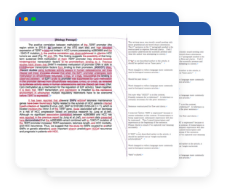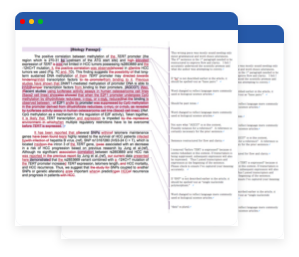动词时态
所有的动词都有时态。时态是动词的一种属性,表示事件发生的时间。时态主要有三种,每一种时态都包括四个状态。这三种时态是过去时、现在时、将来时。这四个状态是一般状态、完成状态、进行状态、完成进行状态。
动词时态及其用法
不同的时态用来描述某个事件究竟是在过去发生的,还是现在正在发生的,或者是将来将要发生的。 如果不确定自己是否使用了正确的时态,可以参考下方动词时态说明并检查文件,或借助语法检查器快速发现并修正时态不一致。
| 动词时态 | 动词用法 | 什么时候使用 | 例句 (以动词run为例) |
|---|---|---|---|
| 一般现在时 |
run |
用于与时间无关的陈述 |
He runs at the park frequently. |
| 现在进行时 |
is/are/am running |
用于描述正在发生的事情 |
He is running at the park now. |
| 现在完成时 |
has/have run |
用于描述过去开始的但可能会持续下去的事情,或者用于强调过去发生的事情对现在的影响 |
He has run every day this week and now looks healthier. |
| 现在完成进行时 |
has/have been running |
用于描述过去开始的但现在正在发生的事情,也用于强调过去发生的事情对现在的影响 |
He has been running for the past hour, and now he must get ready for work. |
| 一般过去时 |
ran |
用于描述过去发生的事情 |
He ran every day for the whole of April. |
| 过去进行时 |
was/were running |
用于强调过去某一事件正在进行的性质,尤指与另一事件有关时 |
He was running at the park when he sprained his ankle. |
| 过去完成时 |
had run |
用于描述发生在过去一个事件之前的另一个事件 |
He had run daily before he sprained his ankle. |
| 过去完成进行时 |
had been running |
用于描述过去开始的但一直持续到现在或最近才刚结束的事情 |
He had been running at the park for two hours, and he had to get ready for work. |
| 一般将来时 |
will run |
用于描述将来会发生的事情 |
He will run every day next month to prepare for the marathon. |
| 将来进行时 |
will be running |
用于描述将来可能会持续一段时间的事情 |
He will be running every day to train for the marathon. |
| 将来完成时 |
will have run |
用于描述从现在到将来某个时刻将要完成的事情 |
He will have run a marathon by the end of next month. |
| 将来完成进行时 |
will have been running |
用于描述将会持续到未来某一特定时刻的事件,也用于强调事件的预期持续时间 |
He will have been running daily for one month by the time of the marathon. |
一般现在时,一般过去时,一般将来时
时态的第一个状态是“一般状态”。一般现在时用来描述现在正在发生或有规律地发生的事件。一般过去时用来描述过去发生的事件。一般将来时用来描述尚未发生的事件。
什么时候使用一般现在时
一般现在时最常见的用法是描述正在发生的事件。然而,一般现在时也用于不受时间推移影响的事实或有规律地发生的事件。
关于事实和解释的描述
事实、理论和科学解释与时间无关。因此,涉及这些内容的陈述都应该使用现在时。
- Example
- The mass of a closed system remains constant over time.
- Example
- The results demonstrate that the proposed model can effectively increase the efficiency of data collection.
关于文本内容的描述
在许多 写作格式指南中,必须使用现在时来描述文本或课程的内容。这是因为就像事实和解释一样,文本内容也不受时间影响。
- Example
- Tolstoy's Anna Karenina begins with the line, “Happy families are all alike; every unhappy family is unhappy in its own way.”
- Example
- In their 2015 paper, Mishra et al. state that a wide network of health facilities, community workers, and volunteers is characteristic of Nepal's health system.
什么时候使用一般过去时
一般过去时用来描述在过去开始和结束的事件。这种时态常用于描述某项研究工作的步骤、解释历史事件或报道过去发生的新闻事件。
报告研究工作步骤
一般过去时通常用来描述研究的方法和结果。这是因为该项研究在大多数情况下都是在过去进行的,而且其结果也是在过去获得的。在论文的方法论述部分,经常使用一般过去时的被动语态,如下面的例子所示。
- Example
- The compound was synthesized from graphite following the proposed method.
- Example
- A quantitative thermogravimetric analysis was performed.
特指过去发生的事情
过去时最显而易见的用法是描述过去发生的事情。这种事情可以是一个新闻或历史事件,也可以是昨天发生的一次购物之旅。
- Example
- World War II officially ended on September 2, 1945..
- Example
- I visited my grandmother in Montauk last weekend.
什么时候使用一般将来时
一般将来时用于假设、预测或将来发生(或将来可能发生)的事件。注意,有些副词可以放在“will”和主要动词之间,正如下面第二个例子所示。
- Example
- We hypothesize that the fabricated composite will exhibit good thermal conductivity.
- Example
- The proposed approach will likely facilitate the development of thermally conductive materials.
- Example
- I will visit my cousins in Seattle next month.
使用其他动词代替将来时
一般将来时的动词通常意味着高度的确定性。因此,在学术写作中如果不想这么确定,那么可以使用其他更为“谨慎”的动词,例如expect、suppose和assume。使用诸如may、might或could等情态动词也能表达可能性,而不会暗示确定性。
- Example
- The proposed approach may facilitate the development of thermally conductive materials.
- Example
- I might visit my cousins in Seattle next month.
现在完成时,过去完成时,将来完成时
时态的第二个状态是“完成状态”。完成时用来表示已经完成、正在完成或将要完成的事件或行为。
什么时候使用现在完成时
现在完成时最常用来描述过去开始的事情,但很可能会继续下去,或者强调过去发生的事情对现在情况的影响。但是,它也可以用来描述在过去不确定的时间点上发生的事情。
描述在过去某个并未指定的时间发生的事件
现在完成时可以表示事件发生在过去的某个并未指定的时间。
- Example
- Lana has made breakfast for her housemates.
- Example
- I have met Keanu Reeves once before.
指向过去的研究
现在完成时强调一个动作已经完成。因此,当提到过去的研究时,如果工作已经完成,而且不强调具体的过去动作,经常可以使用现在完成时。
- Example
- Previous studies have confirmed that this composite material exhibits good thermal conductivity.
- Example
- We have previously developed a novel platform for large-scale data collection.
强调过去的工作对当前的重要性
现在完成时也用于强调过去的事件对现在的影响。它经常用来强调过去的工作对于现在的重要性。
- Example
- As recent research [1],[5],[24],[26] has demonstrated, the third composite has high fragility, which makes practical application infeasible despite the composite’s high thermal conductivity.
什么时候使用过去完成时
过去完成时用于描述发生在另一个过去事件之前的过去事件。它不常用于学术写作,但是经常用于其他类型的写作,以安排叙事性事件。
- Example
- Tommy was surprised to see that Lana had painted her room bright yellow.
- Example
- I thought, if I had caused the cloud, it was my duty to make an effort to dispel it.
什么时候使用将来完成时
将来完成时用来描述从现在到将来某个特定时刻之间将要完成的事情。与过去完成时一样,这种时态在学术写作中并不常见,但是可以用于安排叙事性事件。
- Example
- Lana will have finished painting her room by tomorrow.
- Example
- By the end of the week, I will have left for Australia.
现在进行时,过去进行时,将来进行时
时态的第三个状态是“进行状态”。进行时用来表示事件正在进行的性质。
什么时候使用现在进行时
现在进行时用来描述正在发生的事件。这个动词时态在学术写作中不常用,但是在日常写作和其他写作中很常见。然而,现在进行时也可以用来描述某一事件在将来发生的可能性或将来要做某事的意图。这在讨论未来的研究或研究的可能性结果时很有用。
讨论当前或正在进行的行动或事件
现在进行时最常见的用法是描述正在发生的动作或事件。
- Example
- Lana is painting her room a bright sunflower yellow.
讨论未来的事件或研究
在学术写作中,现在进行时经常用来讨论预期的结果和未来的研究,这是因为现在进行时也可以用来描述意图。
- Example
- We are expecting future studies to help further elucidate the mechanics behind this result.
- Example
- We are planning to further investigate the mechanics behind this result.
什么时候使用过去进行时
过去进行时用来强调过去的事件正在发生,特别是当它与过去的另一个事件或行为有关时。
- Example
- Lara was painting her room until her brother interrupted.
- Example
- The company was still recovering from the recession when its CFO died unexpectedly.
什么时候使用将来进行时
将来进行时用来描述可能会持续一段时间的事件。
- Example
- Lana will be painting her room yellow this upcoming weekend.
- Example
- I will be studying for my exam later.
使用过去、现在或将来的完成进行时
过去进行时和现在完成进行时用来描述发生在过去但正在进行的事件,也用来强调过去的事件或行为对现在的影响。将来进行时表示将持续到未来某一特定时刻的事件,强调事件的预期持续时间。下面三个例子分别对应过去完成进行时、现在完成进行时和将来完成进行时。
- 过去完成进行时
- He had been learning Japanese for six months when he got the opportunity to visit Japan.
- 现在完成进行时
- He has been learning Japanese for almost three years.
- 将来完成进行时
- Next month, he will have been learning Japanese for three years.






